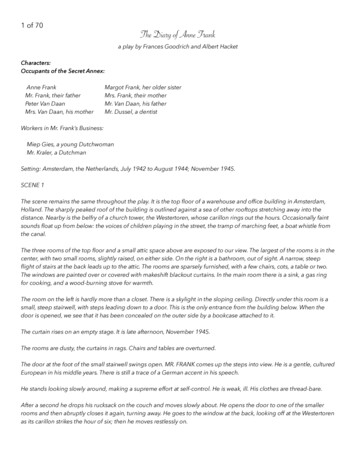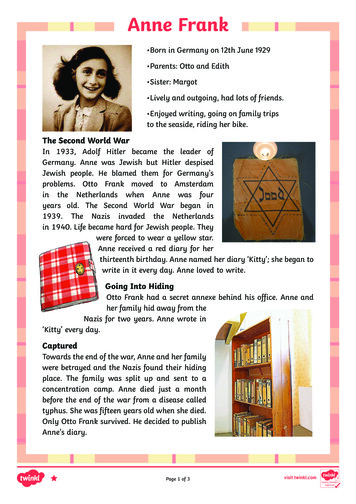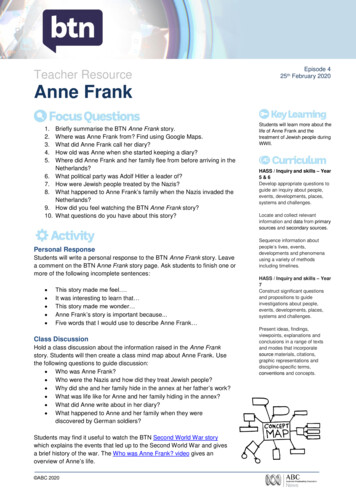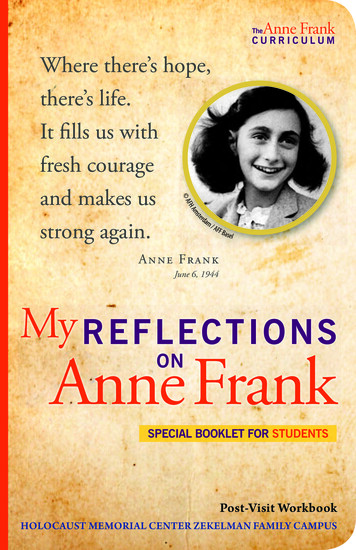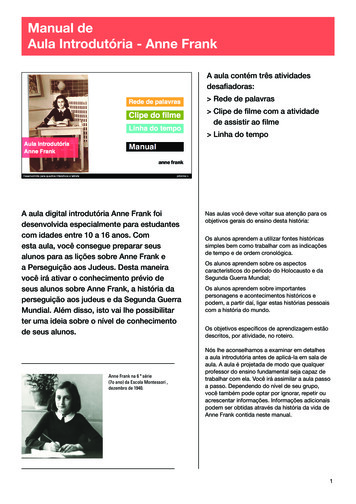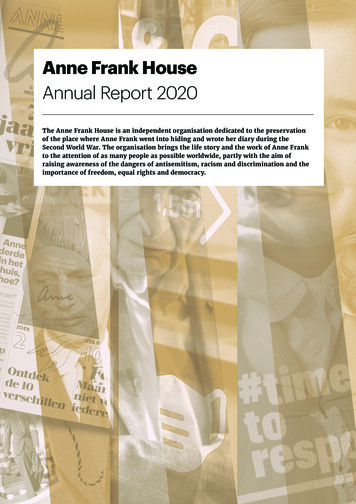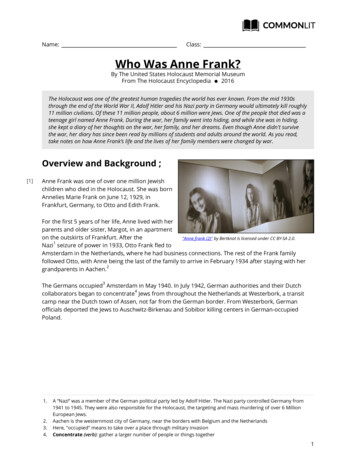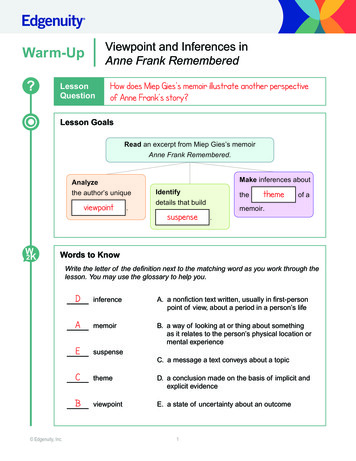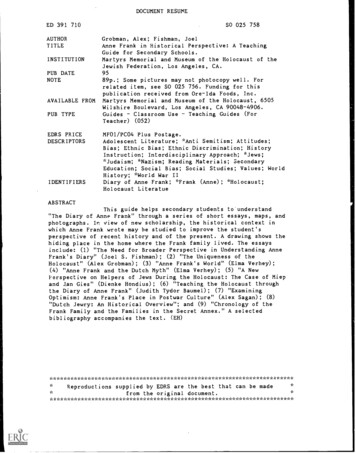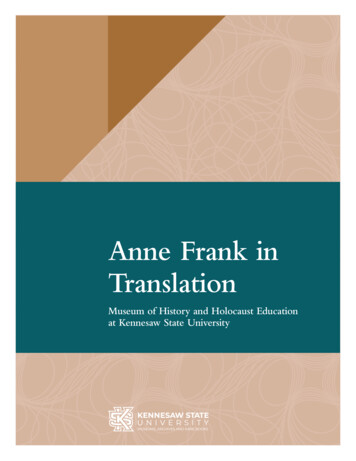
Transcription
Anne Frank inTranslationMuseum of History and Holocaust Educationat Kennesaw State University
Anne Frank inTranslationIllustrations for Anne Frank in TranslationThe Museum of History andInside the IllustrationHolocaust Education (MHHE)worked with two artists to provideillustrations for each of thepanels of the exhibit Anne Frankin Translation. Leonel Warrencompleted four illustrations during astudent internship with the MHHE.Kathy Knapp was commissioned tocomplete another four illustrations.Warren’s and Knapp’s illustrationsare another form of translation:converting moments from Anne’sstory into visual concepts.2The first illustration in the exhibitdepicts the legacy of Anne’sstory through translation. Anne’swell-known figure, photographednumerous times by her father,and now interpreted by a youngartist, is surrounded by pages fromher diary. These pages suggestthe proliferation of Anne’s wordsthrough translation.Illustration above by Leonel Warren.
Quotation from Anne’s Diary“We’re far from rich now, but I’ve pinned allmy hopes on after the war. I can assure you,I’m not so set on a bourgeois life as Mother andMargot. I’d like to spend a year in Paris andLondon learning the languages and studying arthistory. Compare that with Margot, who wants tonurse newborns in Palestine. I still have visionsof gorgeous dresses and fascinating people. AsI’ve told you many times before, I want to see theworld and do all kinds of exciting things, and alittle money won’t hurt!(Monday, May 8, 1944)”Concept drawingfor Panel Oneof Anne Frankin Translation byLeonel Warren.3
What is translation?In its simplest definition,translation means the processof converting words or textfrom one language into another.However, the word embodies abroader definition in its origin oretymology. Translat means “carriedacross” in Latin. The word itselfwas carried across space and timefrom Latin, to Old French, toMiddle English, to modern English.To carry something across spaceand time requires human will andhuman agency. Translation is anactive practice. And althoughthe most common definition oftranslation involves carrying ideasfrom one language to another, abroader definition of translation isused readily in science, math, andengineering: to move somethingfrom one place to another. In thatmovement, change is inevitable,but the essence of the originalis conserved. This exhibit adoptsthe broadest available definitionof translation: the conversionof something from one form or4medium into another. Translationis adaptation, transformation,movement, and change. But itis always rooted in love for theoriginal.The Franks themselves weremultilingual. German was arguablytheir mother tongue, althoughtheir anger with the Nazi regimeprompted them to enact rulesforbidding the speaking of Germanin the Secret Annex. Anne andMargot spoke Dutch fluently, andOtto had become proficient in thelanguage for work. Edith, like manyolder immigrants, was never ascomfortable in the new language asin the one of her birth. Anne,Margot, and Peter studied Englishand French during their quiet daysin the Annex, and Fritz Pfeffertook a course in Spanish. Annewrote about her aspirations tostudy art history in England andFrance when she became a youngwoman. Language held the key toa broader world of possibilities.
Who translated Anne Frank’s diary?The translation of Anne Frank’sdiary from language to languageinvolved a series of partnershipswith publishers around the world.Before his death in 1980, OttoFrank served as one of the diary’sprimary editors, but each publisherput together an editorial team andhired a translator toconvert the text from itsoriginal language to theprimary language of its newtarget audience. To date, AtlasTranslations has documentedversions of Anne’s diary in morethan 70 languages.Translator SpotlightSusan Massotty. Courtesy WordsWithout BordersSusan Massotty was selected byDoubleday as the translator forthe definitive edition of The Diaryof a Young Girl by Anne Frank,edited by Otto Frank and MirjamPressler and released in 1995. Thisversion has since been reprintedwith a new introduction andchronology by Everyman’s Libraryin 2010. Massotty’s translationshave included works by KaderAbdolah, Cees Nooteboom,Abdelkader Benali, and Margrietde Moor. She was awarded theVondel Prize for translation ofDutch literature in 2000. Even athorough internet search yieldslittle in Massotty’s own voice;instead her contributions haveenabled the voices of others topass from language to languageand culture to culture.5
Afrikaans: South AfricaAlbanian: AlbaniaAmhari: EthiopiaArabic: Middle EastArmenian: ArmeniaAssamese: IndiaAzerbaijani: AzerbaijanBahasa: IndonesiaBasque: SpainBengali: IndiaBosnian: BosniaBurmese: ThailandBulgarian: BulgariaCatalan: SpainChinese: ChinaCroatian: CroatiaCzech: Czech RepublicDanish: DenmarkDari: AfghanistanDutch: The NetherlandsGerman: GermanyEnglish: U.S., Canda, andUnited KingdomEsperanto: The HagueEstonian: EstoniaFaroese: Faroe IslandsFarsi: IranFinnish: FinnlandFrench: France, Canada,West AfricaFriesian: FriesiaGaelic: IrelandGalician: Galicia, a regionof SpainGeorgian: Georgia (country)Greek: GreeceGreenlandish: GreenlandHebrew: IsraelHindi: IndiaHungarian: Hungary6
Map showing the languages into which AnneFrank’s diary has been translated and the countriesaround the world where they are spoken.Icelandic: IcelandItalian: ItalyJapanese: JapanKazakh: KazakhstanKhmer: CambodiaKorean: KoreaLaotian: LaosLatvian: LatviaLithuanian: LithuaniaLuxembourgish: LuxembourgMacedonian: MacedoniaMalayayalam: IndiaMarathi: IndiaNepalese: NepalNorwegian: NorwayPapiamento: ArubaPapiamentu: CuracaoPolish: PolandPortugese: Brazil, PortugalRomanian: RomaniaRussian: RussiaSerbian: SerbiaSerbo-Croatian: Serbia/CroatiaSinhalese: Sri LankaSlovakian: SlovakiaSlovenian: SloveniaSpanish: Spain, Mexico,Central and South AmericaSudanese: SudanSwedish: SwedenThai: ThailandTurkish: TurkeyUkranian: UkraineVietnamese: VietnamWelsh: WalesYiddish: Israel, USA(Especially New York City),Canada (EspeciallyMontreal)7
8
Collage of Anne Frank translations in the collection of theBentley Rare Book Museum at Kennesaw State University9
Anne FrankExpressedInside the IllustrationThis illustration by Kathy Knappdepicts Anne writing in her diary.As she stares down at the paper,her words fill the background ofthe scene, imbued with a life oftheir own.IIlustration by Kathy Knapp.10Anne Frank's plaid diary, herfirst journal, in which she wrotefrom 1942-1944. Photo ca. 1950courtesy Anne Frank FondsBasel via Getty Images.
Quotation from Anne’s Diary“My first wish after the war is to become a Dutchcitizen. I love the Dutch, I love this country, I lovethe language, and I want to work here. And evenif I have to write to the Queen herself, I won’tgive up until I’ve reached my goal! I’m becomingmore and more independent of my parents. Youngas I am, I face life with more courage and havea better and truer sense of justice than Mother. Iknow what I want, I have a goal, I have opinions,a religion and love. If only I can be myself, I’llbe satisfied. I know that I’m a woman, a womanwith inner strength and a great deal of courage! IfGod lets me live, I’ll achieve more than Motherever did, I’ll make my voice heard, I’ll go out intothe world and work for mankind!— (Tuesday, April 11, 1944)”11
A Timeline of Anne Frank’s LifeSummerJune 12Anne Frank wasborn in Frankfurt amMain, Germany.1929Anne Frank arrivedin Aachen, Germany,to stay with hergrandmother whileher parents andsister got settled inAmsterdam.1933FebruaryAnne Frank arrivedat her new home inAmsterdam.1934Map of Anne Frank’s Life Journey. Courtesy U.S. Holocaust Memorial Museum12
August 4Anne Frank andher family werearrested andtaken to Gestapoheadquarters inAmsterdam thenimprisoned atWeteringschans.July 6Anne Frank wentinto hiding with herfamily in Amsterdam.1942August 8Anne Frank andher family weretransported toWesterbork.1944February/MarchAnne and MargotFrank die of typhusat Bergen-Belsen.1945September 4Anne Frank andher family weretransported toAuschwitz.October/NovemberAnne and MargotFrank weretransported toBergen-Belsen.13
Anne Frank’s EducationWhen Anne Frank moved toAmsterdam, her parentsenrolled her in a MontessoriSchool. Pioneered by MariaMontessori, an Italian physicianand educator, in 1907, theMontessori philosophy encouragedchildren to take charge of theirlearning through hands-onactivities. Montessori educationremains popular around the world.In 1930s Amsterdam, educationwas subsidized in order to provideall children with opportunities.Anne’s school reflected the14demographics of her neighborhood.Jewish and non-Jewish childrenattended together.After the German invasion of theNetherlands in 1940, Jewish childrenwere no longer allowed to attendschool with non-Jewish children.They were consolidated intosegregated schools. Anne andMargot attended Amsterdam’s JewishSecondary School. It was therethat Anne gained a reputation as a“chatterbox,” an annoying epithet thatshe later wrote about in her diary.Anne Frank in her classroom in the 6th Montessori School, Amsterdam, 1934. Sheis seated near the back in a white dress (circled). Courtesy Anne Frank House
The Montessori School in Amsterdam where Anne Frank went to school from1934 through 1941 is now decorated with a mural based on Anne’s writings inher diary. Courtesy EyalrechesAnne Frank in QuotationEach section of thisgallery guide includesa quotation fromAnne’s diary. Anne’swords have inspiredyoung people aroundthe world as theycontemplate livingthrough hard times.Still of child reading excerpts from Anne Frank’sdiary. This video, an excerpt from ‘In line for AnneFrank’ (The Media Brothers & NOS, 2014), includesyoung girls from around the world reading fromtranslations of Anne’s diary in their own languages.Courtesy Anne Frank House15
Anne FrankProtectedInside the IllustrationThis illustration by Leonel Warren depictsa woman reaching down to discover AnneFrank’s diary strewn on the floor. MiepGies and Bep Voskuijl discovered thediary along with photo albums and otherpapers in the Annex on the day that itsresidents were arrested and taken awayby the Gestapo, August 4, 1944.16Miep Gies stands with herhusband, Jan, at the entrance tothe “Secret Annex” in the AnneFrank House, May 5, 1987. Sheis holding a copy of her memoir,Anne Frank, Remembered.Courtesy National Archives ofthe NetherlandsIllustration above byLeonel Warren.
Quotations from Anne’s Diary“I have plenty of dreams, but the reality is thatwe’ll have to stay here until the war is over. Wecan’t ever go outside, and the only visitors we can haveare Miep, her husband Jan, Bep Voskuijl, Mr. Voskuijl,Mr. Kugler, Mr. Kleiman and Mrs. Kleiman, thoughshe hasn’t come because she thinks it’s too dangerous.“”— (Sunday, July 12, 1942)I see the eight of us in the Annex as if we were a patchof blue sky surrounded by menacing black clouds. Theperfectly round spot on which we’re standing is stillsafe, but the clouds are moving in on us, and the ringbetween us and the approaching danger is being pulledtighter and tighter. We’re surrounded by darkness anddanger, and in our desperate search for a way out wekeep bumping into each other. We look at the fightingdown below and the peace and beauty up above. Inthe meantime, we’ve been cut off by the dark mass ofclouds, so that we can go neither up nor down. It loomsbefore us like an impenetrable wall, trying to crush us,but not yet able to. I can only cry out and implore, ‘Oh,ring, ring, open wide and let us out!— (Monday, November 8, 1943)”17
Miep and Jan Gies and the Dutch ResistanceMiep Gies reading letters from readers in 2001. Miep published her memoir,Anne Frank, Remembered, in 1987. Courtesy Bettina Flitner, Miepgies.nlIn the prologue of her memoir,Miep Gies wrote, “There isnothing special about me. I havenever wanted special attention. Iwas only willing to do what wasasked of me and what seemednecessary at the time. When I waspersuaded to tell my story, I hadto think of the place that AnneFrank holds in history and whather story has come to mean forthe many millions of people whohave been touched by it. I’m toldthat every night when the sun goes18down, somewhere in the worldthe curtain is going up on thestage play made from Anne’s diary.Taking into consideration the manyprintings of Het Achterhuis (“TheAnnex”) – published in English asThe Diary of a Young Girl – and themany translations that have beenmade of Anne’s story, her voice hasreached the far edges of the earth.”Born in Austria, and sent to livewith a Dutch family in 1920, MiepGies felt a kinship with the Jewish
refugees from Nazi Germany whofled to the Netherlands in the1930s. The Dutch had offered hershelter and sustenance when herAustrian family had trouble takingcare of her during the hard timesthat followed the First WorldWar. Otto Frank showed herkindness when she was a youngwoman, offering a job in theoffice of Opekta and recognizingher talent in customer serviceafter she mastered the company’sjam-making process. Otto Frankhelped her navigate internationalbureaucracy in order to become aDutch citizen before her marriageto Jan Gies on July 16, 1941.When Miep and Jan were askedto help the Frank family, theynever hesitated. It was Miep, aswell, who connected her dentist,Fritz Pfeffer, with the Franks andthe Van Pels’ so he could hidebeginning in November 1942.As a social worker for the Dutchgovernment, Jan Gies used hisposition to assist the resistance. Inaddition to his official caseload, hecarried a shadow caseload of youngmen and women attempting toavoid labor conscription or hidingfrom the Nazis after refusing toswear loyalty to the occupiers. TheGies’s also sheltered a young manin their home. All the while, theykept their helping secret; the peoplethey helped did not know aboutthe others who were also beinghelped by the Gies family. In an actof bravery after the residents of theSecret Annex were captured, Miepwent to the offices of the GestapoOtto and AnneFrank walk happilywith other guestsattending Miep andJan’s wedding, July16, 1941. CourtesyAnne Frank House19
in Amsterdam. She risked capture,hoping to offer a bribe for therelease of her friends. She wasturned away when she discoveredthe secret police secretly listeningto the BBC radio.When Otto returned to Amsterdamalone, Miep and Jan took himinto their home. Together, theycelebrated the birth of Miep’s son,Paul, in 1951. Otto stayed withthe family until he remarried andmoved to Switzerland.It wasn’t until forty years after thewar that Miep felt ready to tellher story. After she published hermemoir in 1987, she began speakingpublicly about her experiencesduring the war. She said, “Helpingpeople who are in danger is not amatter of courage but from making adecision that every human being hasto make in his life when he or shedistinguishes between good and bad.”You can watch excerpts of Mieptalking about Anne Frank tch Life During the OccupationThe Museum of History andHolocaust Education had the honorof interviewing two Dutch menin February 2020 whose familiessurvived the Nazi occupation.Marcel Kohler was born inUtrecht, the Netherlands, in 1950,five years after the end of WorldWar II. He is the youngest of threesiblings, with an older brotherborn three years after the war, andan older sister who was a childduring the Nazi occupation of theNetherlands. His family experienced20hardships during the occupation,including food shortages and threatsto their property by the occupyingforces. During the war, they hid their
valuables in secret cabinets, andhis sister later shared stories withhim of Jewish people hidden in theattic. The Kohler family immigratedto the United States in 1955 andsettled in Lansing, Michigan.You can follow Van Driel’s GeorgiaJourney ow/35.Born in Schiedam in 1934, HankVan Driel was celebrating hissixth birthday when the Nazismarched into the Netherlands. Heand his family endured five yearsof hardship and near-starvationrations during the Germanoccupation. After the war, VanDriel studied to become a chef andworked at hotels and restaurantsin Rotterdam, eventually landing ajob on the Holland America line ofcruise ships in 1962. Attracted bysteady work in the American resortindustry, Van Driel immigratedto the United States in 1964. Hehas remained a citizen of theNetherlands and travels frequentlybetween the countries.Wanting to end the war by the endof 1944, the Allied forces launchedOperation Market Garden whichintended to invade NorthernGermany through the Netherlands.The failure of this campaign ledto only some of the Netherlandsbeing liberated with Allied forceshalted at the Rhine River. Germanblockades of food and suppliesfrom the non-liberated parts ofthe Netherlands led to thousandsdying, creating the Hongerwinter, orthe Dutch Famine of 1944-45. Thefamine ended when Allied forceswere able to liberate the rest of theNetherlands in May 1945.Described in Gies’s memoir aswell as Kohler and Van Driel’s oralhistories, the “Hunger Winter” of1944-1945 was the worst part ofthe occupation experienced by theDutch people. After a summer ofhope following the D-Day landingsby the Allies in Normandy, thepeople of the Netherlands thoughttheir liberation was imminent.Anne described these hopeful timesin her diary.21
Anne FrankAppreciatedInside the IllustrationThis illustration by Kathy Knappdepicts Otto Frank reading Anne’sdiary upon his return to Amsterdamin 1945. Otto was amazed by thequality of Anne’s writing and by hercomplex inner life.Illustration by Kathy Knapp.22Otto Frank at the unveilingof the Anne Frank statue onWestermarkt in Amsterdam,March 14, 1977. CourtesyNational Archives of theNetherlands
Quotation from Anne’s Diary“The poem Father composed for my birthdayis too nice to keep to myself. Since Pim writeshis verses only in German, Margot volunteered totranslate it into Dutch. See for yourself whether Margothasn’t done herself proud. It begins with the usualsummary of the year’s events and then continues:As youngest among us, but small no more,Your life can be trying, for we have the choreOf becoming your teachers, a terrible bore.‘We’ve got experience! Take it from me!’‘We’ve done this all before, you see.We know the ropes, we know the same.’Since time immemorial, always the same.One’s own shortcomings are nothing but fluff,But everyone else’s are heavier stuff:Faultfinding comes easy when this is our plight,But it’s hard for your parents, try as they might,To treat you with fairness, and kindness as well;Nitpicking’s a habit that’s hard to dispel.When you’re living with old folks, all you can doIs put up with their nagging -- it’s hard but it’s true.The pill may be bitter, but down it must go,For it’s meant to keep the peace, you know.The many months here have not been in vain,Since wasting time goes against your Brain.You read and study nearly all the day,Determined to chase the boredom away.The more difficult question, much harder to bear,Is ‘What on earth do I have to wear?I’ve got no more panties, my clothes are too tight,My shirt is a loincloth, I’m really a sight!To put on my shoes I must off my toes,Oh dear, I’m plagued with so many woes!’— (June 13, 1943)”23
Inside the Secret AnnexFollow this link to take a virtual tour of the Secret Annex. This tourwas created by the Anne Frank House in secret-annex/The Annex’s Other ResidentsAlthough Anne Frank became themost famous resident of the SecretAnnex at 263 Prinsengracht, everyresident had their own story. Theyall went into hiding with uniquepre-war experiences, and theyall had hopes and dreams for thefuture.FRITZ PFEFFERFritz Pfeffer ca. 1940. CourtesyAnne Frank House24 Pre-war: Born April 30, 1889. Successful dentist in Berlin,Germany. Divorced, with young son, Werner.In a relationship with CharlotteKaletta, a Catholic. Wartime: After Kristallnacht, heplaced his son on a Kindertransportto England and fled withCharlotte to the Netherlands. Became friends with the Franks,the Van Pels family, and the Giesfamily. Life in Hiding: Moved into theSecret Annex on November 16,1942. Surprised to discover that theFranks and Van Pels’ were hidingin Amsterdam. Shared Anne’s room, a challengingarrangement for a teenager and aman in his 40s. Hopes and Dreams for theFuture: Hoped to start a new lifewith Charlotte in South America;Learned Spanish in preparation.
Fate: After the raid on theSecret Annex on August 4, 1944,he ended up doing hard labor atthe Neuengamme concentrationcamp. Died December 20, 1944, of agastrointestinal infection.PETER VAN PELSPeter van Pels working on theseat of a chair, May/June 1942.Courtesy Anne Frank House Pre-war: Born November 8,1926. Son of August and Hermannvan Pels, a Jewish family fromOsnabruch, Germany. The family fled Germany andmoved to Amsterdam in 1937due to Nazi antisemitsm. Wartime: In Amsterdam, Peter’sfather worked for Otto Frank. The Van Pels’ family decided togo into hiding when call-ups forforced labor in Germany wereincreasing. Life in Hiding: Moved into theSecret Annex on July 13, 1942. Peter had his own room, a tinyspace at the base of the stairs thatled to the attic. He was encouraged by Anne andMargot to focus on his studies,although he seemed to prefertinkering. Peter and Anne grew closerduring the spring of 1944,spending time together in theattic where they kissed andcuddled. At the start of thesummer, Anne’s affection for Peterbegan to cool. Hopes and Dreams for theFuture: Hoped to go to theDutch East Indies and live on aplantation. Fate: After the people of theSecret Annex were capturedon August 4, 1944, Peter andAnne spent time together at theWesterbork transit camp. On September 3, the Van Pels’and the Franks were transportedto Auschwitz-Birkenau. He wasseparated from Anne, Margot, andhis mother at the platform. Peter was assigned to theAuschwitz post room and wasable to get some extra food25
periodically, which he sharedwith his father and Otto. With the approach of theSoviet army, Peter was forced toevacuate Auschwitz along withall other able-bodied prisoners.He arrived at Mauthausen in thespring of 1945. After being overworked inthe mines at the Melk satellitecamp, Peter ended up in the sickbarracks and died on May 10,1945, five days after Americantroops liberated the camp.AUGUSTE VAN PELSAuguste Van Pels, ca. 1920.Courtesy Anne Frank House Pre-war: Born September 29,1900 in Germany as AugusteRottgen.26 Married the Dutch citizen,Hermann van Pels in 1925. Gave birth to their son, Peter, inNovember 1926. Wartime: Concerned about therising tide of antisemitism, the VanPels moved to Amsterdam in 1937where they lived in the sameneighborhood as the Franks. Auguste kept house and took careof boarders in order to bring inextra money. Life in Hiding: Moved into theSecret Annex on July 13, 1942. Auguste took on much of thecooking in the Secret Annex,trying to prepare tasty meals withscant ingredients. It was difficult for Auguste toadjust to a life without luxuries,and Anne described fightsbetween her and Hermann; theworst occurred, according toAnne, when Hermann forced herto sell her fur coat to finance thecontinuation of their hiding. Hopes and Dreams for theFuture: Auguste hoped to returnto a life similar to the one shehad before going into hiding.She passed the time readingbiographies and novels andlearning English and Dutch. Fate: Captured by the Gestapoon August 4, 1944, and sent toWesterbork transit camp.
On September 3, the Van Pels’and the Franks were transportedto Auschwitz-Birkenau. Augusteremained with Margot, Anne, andEdith. On November 1, 1944, Augustewas transported to BergenBelsen along with Anne andMargot. In February 1945, Auguste wastransported to Raguhn, a satellitecamp of Buchenwald. A fewweeks later, she was put on atransport to Theresienstadt. Witnesses gave testimony to herdeath during the transport fromRaguhn to Theresienstadt-- onestated that she died from typhusand was placed beside the trackswhile another said that shewas thrown under the train byGerman soldiers.HERMANN VAN PELSHermann and Auguste van Pelson their way to the wedding ofMiep Santrouschitz and Jan Gies,July 16, 1941. Courtesy AnneFrank House Pre-war: Born March 31, 1898,in Osnabruck, Germany, but hadDutch citizenship through hisfather who was from Groningen,the Netherlands. Married Auguste Rottgen onDecember 25, 1925. Their son, Peter, was born inNovember 1926. Hermann worked for his father’sbutcher supply company from1932 until 1937. Wartime: Concerned about therising tide of antisemitism, theVan Pels’ moved to Amsterdamin 1937 where they livedin the same neighborhoodas the Franks and set up atextile trading company withHermann’s brother. He began working for OttoFrank as a specialist in herbsand spices used in the makingof sausages. Otto’s secondbusiness, Pectacon, traded inherbs and spices. He worked with Otto to setup the hiding place behind theOpekta offices in the spring of1942. Life in Hiding: Moved into theSecret Annex on July 13, 1942. He continued to remaininvolved in Pectacon whilein hiding, working throughbusiness correspondence.27
Hermann found a reliablebutcher to supply meat for thefamilies and also relied on thehelpers for a supply of cigarettes. Hopes and Dreams for theFuture: Hermann hoped toreturn to business after the warand was very optimistic afterD-Day in 1944. Fate: Captured by the Gestapoon August 4, 1944, Hermanntried to bribe SS-HauptscarfuhrerKarl Joseph Silberbauer to let theeight people go for money, butSilberbauer did not respond. After spending almost a monthat Westerbork transit camp, theVan Pels and Frank familieswere transported to AuschwitzBirkenau on September 3, 1944. Hermann worked in roadconstruction outside the campalong with Otto Frank andFritz Pfeffer until he injured hishand and had to remain in thebarracks. Witnesses gave testimony to hismurder in the gas chambers inOctober 1944.28MARGOT FRANKMargot Frank at the JewishLyceum, December 1941. CourtesyAnne Frank House Pre-war: Born February 16, 1926,in Frankfurt am Main, Germany. Moved to Amsterdam with herfamily in 1933, when she wasseven years old. Margot was a good studentand picked up Dutch quicklywhile attending a neighborhoodprimary school; she continued toexcel, especially in science andmath at the municipal Lyceum forGirls. Wartime: Margot was aware ofthe beginning of the war. In aletter to an American pen pal onApril 27, 1940, she wrote “Weoften listen to the radio, for theseare stressful times.”
In the fall of 1941, she had totransfer from the municipalLyceum for Girls to the JewishLyceum. She missed her nonJewish friends and had to give upon tennis and rowing, since Jewswere no longer permitted to playsports. On July 5, 1942, Margot receiveda summons to report to a laborcamp in Germany. Fearing thiswas a death-sentence, the Frankfamily got ready to go intohiding immediately. Life in Hiding: Moved into theSecret Annex on July 6, 1942. Anne described Margot’s studiesas including English, French,Latin, Shorthand, Mechanics,Trigonometry, Geometry, Physics,Chemistry, Algebra, Literature,Bookkeeping, Geography,Modern History, Biology,Economics, Religion, andMedicine. Like Anne, Margot kept a diary,but hers did not survive the war;Margot often seemed lonely inthe Secret Annex. Hopes and Dreams for theFuture: Margot hoped tobecome a maternity nurse inPalestine. Fate: Captured by the Gestapoon August 4, 1944. After spending almost a monthat Westerbork transit camp, theVan Pels and Frank familieswere transported to AuschwitzBirkenau on September 3, 1944. Margot remained with Anne andtheir mother at Auschwitz untilshe and Anne were transportedto Bergen-Belsen on November1, 1944. Margot and Anne remainedtogether; due to terribleconditions, they both succumbedto spotted typhus in February1945, just two months before thecamp was liberated by the Britishmilitary.EDITH FRANKA youthful Edith Hollander in the1920s. Courtesy Anne Frank House Pre-war: Born January 16, 1900,in Aachen, a German city closeto the Dutch border.29
Grew up in a wealthy Jewishfamily; Edith enjoyed familyparties and holidays by the seasideand helped with the family’sbusinesses. Married Otto Frank on May 8,1925. The couple moved to theMarbachweg, a new housingestate in Frankfurt am Main,Germany. There, their daughterMargot was born in 1926 andAnne was born in 1929. The family made the decision toleave Germany in 1933, shortlyafter Adolf Hitler came to power.They found a new home on theMerwedeplein in Amsterdam. Edith kept house while Ottoconcentrated on building hisbusinesses, but she had sometrouble learning Dutch andgetting used to her new life. Wartime: Edith’s familyexperienced the violence ofKristallnacht in Germany. Herbrother Walter was imprisonedin a concentration camp brieflybefore managing to emigrate tothe United States, along with herbrother Julius. Edith’s mother, Rosa HollanderStern, moved in with the familyin the Netherlands in 1939 andlived with them until her deathin 1942.30 Life in Hiding: Moved into theSecret Annex on July 6, 1942. Anne and Edith often clashedduring their time in hidingtogether. Edith encouraged her children’sreligious education but oftensuffered from feelings of despair. Hopes and Dreams for theFuture: Witnesses have noted thatEdith had a hard time imagining afuture for the family. Fate: Captured by the Gestapo onAugust 4, 1944. The Frank family was madeto live in a special barracks forpeople who had defied the willof the Nazis; they had to take oldbatteries apart which was workboth filthy and unsafe. After spending almost a monthat Westerbork transit camp, theVan Pels and Frank familieswere transported to AuschwitzBirkenau on Septe
Anne Frank Expressed Anne Frank's plaid diary, her first journal, in which she wrote from 1942-1944. Photo ca. 1950 courtesy Anne Frank Fonds-Basel via Getty Images. Inside the Illustration This illustration by Kathy Knapp depicts Anne writing in her diary. As she stares down at the paper, her words fill the background of
